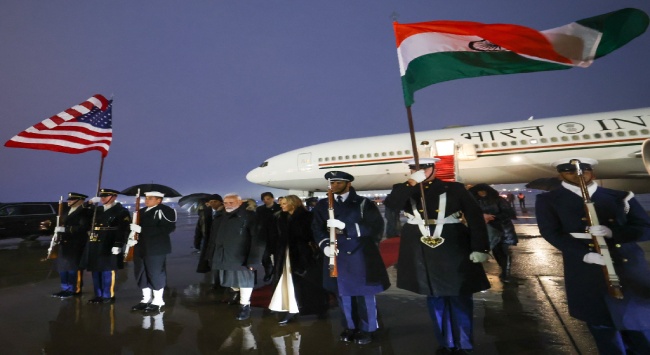Summary
The Donald Trump and Narendra Modi governments will begin negotiating a bilateral trade agreement (BTA). While conceding some tariffs, India should use the BTA to get more American investments in services.
The Joint Leaders Statement issued after the meeting between United States President Donald Trump and Indian Prime Minister Narendra Modi on 13 February 2025 mentioned “plans to negotiate the first tranche of a mutually beneficial, multi-sector Bilateral Trade Agreement (BTA) by fall of 2025”. The wide-ranging and innovative BTA will “strengthen and deepen” bilateral trade in goods and services by increasing market access, reducing tariffs and non-tariff barriers (NTBs) and deepening supply chain integration.
The BTA will be negotiated under specific contexts. These include ‘Mission 500’ for more than doubling the size of bilateral trade in goods and services to US$500 billion (S$670 billion) by 2030. In 2023, US-India trade in goods and services was around US$190 billion (S$254 billion), out of which, US$124 billion (S$166 billion) was trade in goods, and US$66 billion (S$88 billion) was trade in services. The US was in deficit in both goods and services trade, with the former being around US$44 billion (S$59 billion) and the latter a much smaller US$6 billion (S$8 billion).
The BTA has also contextualised Trump’s reciprocal tariff plans, along with the goal of ensuring fair and reciprocal trade. Both plans were announced hours before Trump’s meeting with Modi. Reciprocal tariffs on the US’ trade partners will aim to reduce bilateral trade deficits and will be calculated on the basis of the tariffs faced by American exports to partner country markets, along with other market access inhibiting factors like NTBs, government subsidies, extra-territorial taxes and exchange rate policies. The reciprocal tariffs need to be viewed along with the Trump administration’s objective of ensuring fair and reciprocal trade by correcting trade imbalances with major partners.
A further context is India’s identification by the Trump administration as a major inhibitor of market access for American products. This is evident from India being specifically mentioned, along with Brazil and the European Union, in the fair and reciprocal plan on trade. The specific reference to India is for its high tariffs on agricultural products and motorcycles.
The BTA is to be prepared by the fall of 2025, possibly beginning from August 2025, till up to about early December 2025. The deadline should be noted, along with the fact that reciprocal tariffs could be ready well before then and could influence negotiations at their later stages.
There is much at stake for India in the BTA, given that the US is India’s largest export market and second largest trade partner. It is one of India’s most significant global partners – a country with which its political, economic and people-centric links have deepened significantly over the years.
The BTA will be a test of how far India is willing to accommodate the US in its efforts to reduce bilateral trade imbalance by removing market access barriers; and also, how much India is able to expand its own economic and security agenda through the framework. India’s negotiations need to be tactful and forward-looking in this regard.
India has already cut tariffs on some major US exports such as high-end motorcycles and bourbon whiskey. Going forward, it might need to slash tariffs on imported electric vehicles to increase local market access for Tesla, as well as on several agricultural exports, such as dairy, fruits and vegetables. Cutting tariffs on dairy will be politically difficult. India’s best strategy might be to go for phased cuts. This might not be necessary for many other items though, as many US exports are not items for mass consumption in India.
India’s big ‘wins’ in the BTA should target services. It should trade-off tariff cuts on US exports vis-à-vis the benefits it picks up in services. India already enjoys a strong reputation among leading US businesses for being an ideal location to establish Global Capability Centres (GCCs). The US’ pharmaceutical major, Eli Lilly, is the latest to expand its GCC presence in India by opening another centre in Hyderabad after an earlier one in Bengaluru.
With US businesses eyeing India for more long-term investments in technology and innovative sectors, India should capitalise on the sentiments in the BTA. More on-site US presence in GCCs can also help India in negotiating better deals for short-term movements of professionals, as they travel back and forth between their Indian and US operations.
What is unlikely to work for India is efforts to restore the Generalised System of Preferences (GSP). That ship has sailed with the Trump administration in no mood to offer duty-free concessions. Rather than squandering energy on the GSP, India should focus on getting more US investments to raise its service exports. A service trade deficit will not bother the US as much as goods, as investments in services in India also bring profits for US businesses. This is clearly the way to go forward.
. . . . .
Dr Amitendu Palit is a Senior Research Fellow and Research Lead (Trade and Economics) at the Institute of South Asian Studies (ISAS), an autonomous research institute at the National University of Singapore (NUS). He can be contacted at isasap@nus.edu.sg. The author bears full responsibility for the facts cited and opinions expressed in this paper.
Pic Credit: X
-
 More From :
More From :
-
 Tags :
Tags :
-
 Download PDF
Download PDF


